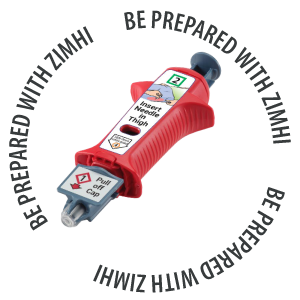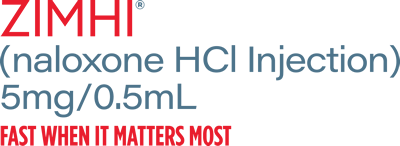EVERY
MOMENT
MATTERS
The strength to pull them back from an overdose
Only ZIMHI offers the HIGHEST DOSE of naloxone available as an intramuscular injection to get it into the blood fast.

EVERY
MOMENT
MATTERS
The strength to pull them back from an overdose
naloxone available as an intramuscular
injection to get it into the blood fast.


EVERY
MOMENT
MATTERS
The strength to pull them
back from an overdose
Only ZIMHI offers the HIGHEST DOSE of
naloxone available as an intramuscular
injection to get it into the blood fast.
LEARN ABOUT ZIMHI
Select your role in the patient’s life to learn more about how ZIMHI can help.
See how ZIMHI can help you be prepared during an opioid overdose emergency
Learn why ZIMHI may be an optimal naloxone choice in today’s opioid overdose environment
Help ensure patients are prepared with high-dose, intramuscular naloxone in the event of an overdose emergency
Discover why today’s
opioid overdose emergencies may require a product like ZIMHI
LEARN ABOUT ZIMHI
Select your role in the patient’s life below to learn more about how ZIMHI can help.
See how ZIMHI can help you be prepared during an opioid overdose emergency
Learn why ZIMHI may be an optimal naloxone choice in today’s opioid overdose environment
Help ensure patients are prepared with high-dose, intramuscular naloxone in the event of an overdose emergency
Discover why today’s
opioid overdose emergencies may require a product like ZIMHI
In an opioid overdose emergency,
ZIMHI MAY MAKE ALL
THE DIFFERENCE


In an opioid overdose emergency,
ZIMHI MAY
MAKE ALL THE
DIFFERENCE


In an opioid overdose emergency,
ZIMHI MAY
MAKE ALL THE
DIFFERENCE
INDICATION
ZIMHI is an opioid antagonist indicated for the emergency treatment of known or suspected opioid overdose, as manifested by respiratory and/or central nervous system depression in adult and pediatric patients. ZIMHI is intended for immediate administration as emergency therapy in settings where opioids may be present. ZIMHI is not a substitute for emergency medical care.
IMPORTANT SAFETY INFORMATION
As the duration of action of naloxone hydrochloride is shorter than many opioids, keep the patient under continued surveillance and administer repeated doses of naloxone using a new ZIMHI device, as necessary, while awaiting emergency medical assistance.
Reversal of respiratory depression caused by partial agonists or mixed agonists/antagonists, such as buprenorphine and pentazocine may be incomplete. Repeat doses of ZIMHI may be required.
Use in patients who are opioid dependent may precipitate opioid withdrawal. In neonates, opioid withdrawal may be life-threatening if not recognized and properly treated. Monitor for the development of signs and symptoms of opioid withdrawal.
Abrupt postoperative reversal of opioid depression may result in adverse cardiovascular (CV) effects. These events have primarily occurred in patients who had pre-existing CV disorders or received other drugs that may have similar adverse CV effects. Monitor these patients closely in an appropriate healthcare setting after use of naloxone hydrochloride.
After use, the ZIMHI needle is exposed until the safety guard is deployed. A needlestick injury could occur during use in emergency situations. In the event of accidental needlestick injury, medical attention should be sought.
The following adverse reactions were most commonly observed in ZIMHI clinical studies: dizziness, lightheadedness, and elevated bilirubin.
To report SUSPECTED ADVERSE REACTIONS, call 1-800-230-3935 or FDA at 1-800-FDA-1088 or www.fda.gov/medwatch
IMPORTANT SAFETY INFORMATION and INDICATION for ZIMHI™
As the duration of action of naloxone hydrochloride is shorter than many opioids, keep the patient under continued surveillance and administer repeated doses of naloxone using a new ZIMHI device, as necessary, while awaiting emergency medical assistance.
Reversal of respiratory depression caused by partial agonists or mixed agonists/antagonists, such as buprenorphine and pentazocine may be incomplete. Repeat doses of ZIMHI may be required.
IMPORTANT SAFETY INFORMATION and INDICATION for ZIMHI™



